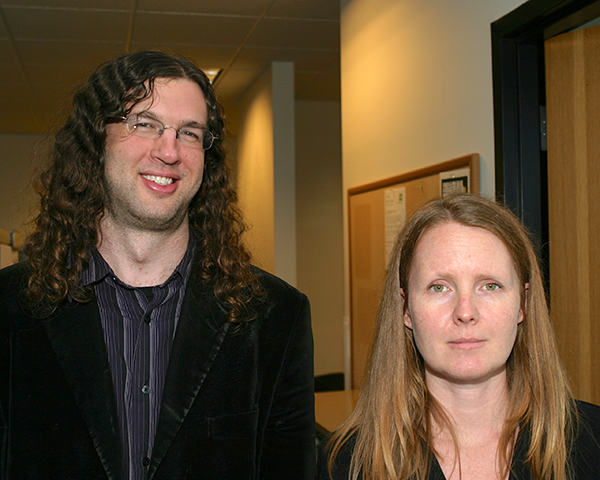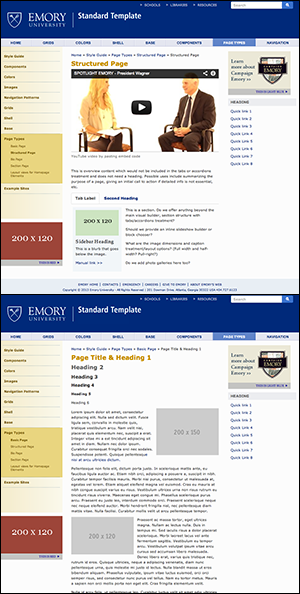Emory now has a state-of-the art tool for web development, the Standard Template, Version 2. This new web development template offers revamped functionality designed for today’s multi-device web environment while leveraging Emory’s branding.
The template is fully mobile-responsive, meaning that websites using the new version will accommodate everything from laptops to tablets to smart phones, adapting to different vertical and horizontal views on those devices. The responsive design has also been customized to be touch-friendly, an important element for mobile access.
The design of the template was a collaborative effort between Research and Woodruff Health Sciences IT (R-WIT), University Technology Services (UTS) and Emory Marketing and Communications (MarComm).
“We took the baseline that UTS and MarComm created four years ago (the header, unit signature, and utility navigation that contains the schools and libraries), extended the initial functionality of the original template, and tried to add in as many of the newer evolutions in web technology as we could,” says Web Design Group senior manager Rachelle Willoughby.
“In 2009, Rich Mendola, then vice president of information technology, and I collaborated to develop the policy that new websites at Emory would use the Emory template in Cascade,” said Ron Sauder, vice president of Communication & Marketing. “The strategy behind our thinking was to visually unite Emory’s online presence to increase the effectiveness of what has become the most visible presentation of Emory around the world and to provide a way for units to reduce administrative costs for their websites. We’ve heard expressions of appreciation from schools and units who have taken advantage of the templates and V2 is another way our groups are serving the Emory community by ‘mobilizing’ Emory websites broadly conceived.”
The original standard template, based on the design of www.emory.edu, was developed in 2008 by Lee Clontz (Senior Web Developer, Academic Technology Services) and John Mills (Executive Web Producer, Emory Communications and Marketing) for the purpose of making Emory a recognizable and consistently-branded online entity.
“Before then,” said Mills, “if you wanted a website at Emory, you had to either hire your own web development team or contract out to multiple vendors, negotiate a contract, etc. With this new template, I can open a ticket to provision a new site and typically get it created the same day, already fully mobile-responsive and ready for content to be added. V2 is free and easy to use.”
In addition to Mills and Willoughby, the collaboration included web developers Lindsay Paroczai, Emily Porter, and Jonathan Stegall from the Web Design Group (WDG), Kevin Chen and Steve Collins from the UTS Integration Web Team, and Jan Gleason and Stanis Kodman from MarComm.
The idea for developing a new standard template arose when the Web Design Group noticed it was constantly getting the same internal requests: Can you build pages for staff and faculty bios? Can you build pages that allow alphanumeric sorting? Can you build a different rotating photo slide show? As a service center, the WDG team envisioned a better way to accommodate those requests by adding the commonly requested features into the standard template.
The requirements gathering for the template redesign included endusers and developers, as well as an exhaustive review of all of the custom functionality provided throughout Emory’s web infrastructure. While the original template met the needs for smaller business units, the new version allows much larger and complex entities to develop web pages without needing customization.
Some of the new features of the template include an array of drop-in widgets for news, calendars, social media, featured content, as well as improved search capabilities. The template also makes it easier for Cascade users by providing a dashboard for overall website settings. This allows for a wider variety of navigational elements and Emory-approved branding options, enabling various departments to look unique while maintaining Emory’s branding standards. Also new are online documentation and a style guide, now in place to help website owners and editors.
According to Collins, “In the past, troubleshooting Emory’s web environment has been difficult because of the wide variety of custom development. A lot of skilled people were doing one-off jobs to fix problems.” But Willoughby thinks that will change with the new standard template. “The template will free our website community to concentrate more on the purpose and strategy of their sites,” she said. “Our goal is to help people make their websites truly useful for their target audience.”
The new version of the standard template has the potential to place Emory on the leading edge of university web development. “Few of the universities that Emory benchmarks even have responsive websites,” said Stegall. “The template increases our ability to be fully adaptive to mobile and handheld technology.” Added Mills, “Mobile responsiveness is the latest and greatest thing. That aspect alone would make me want to use this new template.”



